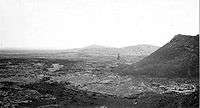Geology of Idaho

Washington, Oregon, and Idaho
The Geology of Idaho is complex, with outcroppings of differing ages of volcanics, undifferentiated metamorphics and sedimentary structures.
Idaho Geologic Survey
Since 1919, the Bureau of Mines and Geology of Idaho has studied and reported on the general and environmental geology of the state.The Bureau was renamed the Idaho Geologic Survey in 1984. The organization also studies and reports on the water (both surface and ground), mineral data, and energy assets of the state.[1]
Geologists and hydrologists on staff at the agency research, make reports based on their research, and produce maps for the state. The University of Idaho administers the program in Moscow and in Boise (Boise State University) and Pocatello (Idaho State University.)
Regions
Panhandle
The region of the Idaho Panhandle reaches from the Canadian border south to Interstate Highway 90.![]() The area consists generally of Precambrian sedimentary formations, some of which have metamorphosed into slates. The area includes the Selkirk Mountains, the Purcell trench and the Cabinet Mountains. Lead, silver and other ores are mined in the Coeur d’Alene Mining District.[2]
The area consists generally of Precambrian sedimentary formations, some of which have metamorphosed into slates. The area includes the Selkirk Mountains, the Purcell trench and the Cabinet Mountains. Lead, silver and other ores are mined in the Coeur d’Alene Mining District.[2]
Central Idaho

Snake River Plain

The Grouse Creek block forms the central part of the south, extending over the state border to Nevada and Utah. It was formed over 2.5 billion years ago.[3]
See also
References
- ↑ "About the Idaho Geological Survey". Idaho Geological Survey. Retrieved 2007-04-11.
- ↑ Alt, David D.; Hyndman, Donald W. (1989). Roadside geology of Idaho. Missoula, MT: Montana Press Publishing. ISBN 0-87842-219-6.
- ↑ Foster, David A; Paul A Mueller; David W Mogk; Joseph L Wooden; James J Vogl (2006). "Proterozoic evolution of the western margin of the Wyoming craton: implications for the tectonic and magmatic evolution of the northern Rocky Mountains" (PDF). Canadian Journal of Earth Sciences 43 (10): 1601–1619. doi:10.1139/E06-052. ISSN 0008-4077. Retrieved 29 December 2012.
| ||||||||||||||